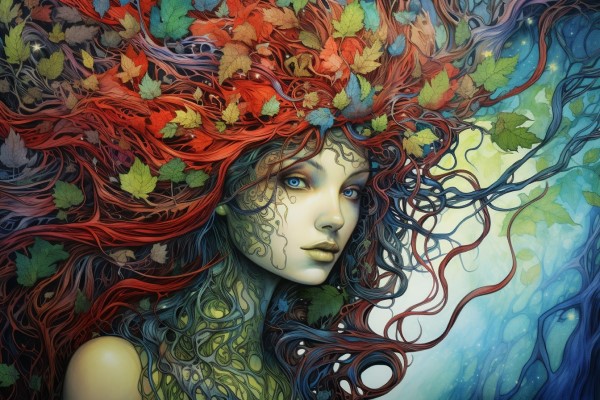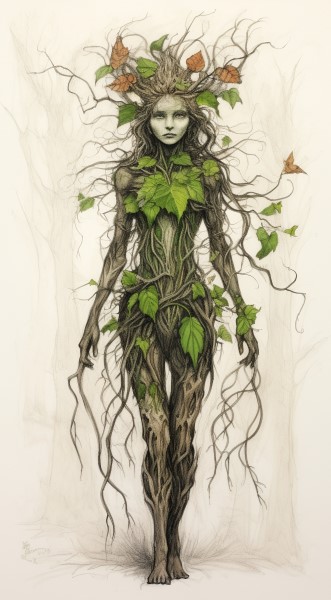KidZone Geography: Greece
Nymphs: The Enchanting Spirits of Nature
In the magical world of Greek mythology, nymphs are enchanting spirits that embody the vibrant life of nature. These beautiful beings are often depicted as young maidens, each connected to a specific element of the natural world, such as forests, rivers, mountains, or the sea. Let's explore the captivating world of nymphs and discover the roles they play in the tales of gods and heroes.

Common Types of Nymphs
Nymphs are classified based on the natural feature or element they are associated with. Here are some of the most well-known types:
Naiads: Nymphs of Freshwater
Naiads are graceful nymphs who inhabit rivers, springs, streams, and lakes. They are known for their beauty and their close connection to the freshwaters they preside over, often helping plants to grow and animals to thrive.
Dryads and Hamadryads: Nymphs of the Trees and Forests
Dryads are the nymphs of the forests, living among the trees and often seen dancing in the woods. Hamadryads are a special type of dryad that is born with a particular tree and shares its fate; if the tree dies, so does the hamadryad.
Oreads: Nymphs of the Mountains
Oreads reside in the mountains and rocky outcrops, embodying the rugged beauty of the highlands. They are often depicted frolicking on mountain peaks or resting in hidden caves.
Oceanids and Nereids: Nymphs of the Sea

Oceanids and Nereids are the nymphs of the vast oceans and seas. Oceanids are daughters of the Titan Oceanus and his sister Tethys, while Nereids are the daughters of Nereus, the old man of the sea. They both protect sea creatures and sailors, guiding them through storms.
Less Commonly Known Types of Nymphs
In the realm of Greek mythology, nymphs are ethereal beings, each embodying the spirit of the natural elements they represent. Beyond the well-known Naiads, Dryads, Oreads, and Oceanids, there exist lesser-known yet equally captivating types of nymphs associated with other aspects of the natural world, such as flowers, breezes, and caverns. Let's delve into the mystical world of these enchanting spirits.
 Anthousai: Nymphs of Flowers
Anthousai: Nymphs of Flowers
The Anthousai, with their ethereal presence, weave through the tapestry of nature, nurturing each bud and bloom with dewdrops at dawn and whispering growth into every petal under the moon's soft gaze. These guardians of blossoms are revered not only for their aesthetic contributions but also for their role in the cycle of life, ensuring the pollination and propagation of plants.
In times of spring, their power is at its zenith, painting the earth with a kaleidoscope of colors, from the deepest reds of roses to the vibrant yellows of sunflowers. Their dance is said to inspire poets and artists, capturing the ephemeral beauty of nature in art and verse. Through the ages, the Anthousai remind us of the fragile yet profound beauty of life, teaching humanity to cherish and protect the natural splendors of the world, for just like the fleeting bloom of a flower, such beauty is both transient and precious, to be held in awe and reverence.
Aurae: Nymphs of the Breeze
The Aurae are the gentle nymphs of the breeze, sisters of the air, who ride the wind's currents, spreading the cool whispers of the wind across the land. Their touch is as soft as a morning mist, and their presence is felt in the refreshing gusts that relieve the summer's heat. These nymphs are often invoked by sailors and travelers, seeking favorable winds to guide their journeys.
 Chthonic Nymphs: Guardians of the Underworld
Chthonic Nymphs: Guardians of the Underworld
In the veiled depths where light scarcely touches, the Chthonic nymphs thrive, weaving their magic in the intricate labyrinths of underground rivers and caverns, their domain a mosaic of shadow and stone. These nymphs, shrouded in the mystique of the subterranean, serve as the custodians of ancient wisdom and lost relics, their songs echoing through the hollows in haunting melodies that tell tales of the earth's ancient past. They are the unseen nurturers, their touch coaxing minerals into the veins of the world's flora, enriching the soil above with life-sustaining nutrients. In their silent vigil, they witness the cyclical dance of decay and rebirth, embodying the profound truth that in darkness, there is the potential for the greatest growth.
Their realm is a testament to the unseen forces that shape our world, a reminder that beneath the chaos of the surface lies an order and beauty in the depths, governed by these enigmatic guardians of the earth's hidden heart. Through their existence, the Chthonic nymphs challenge us to look beyond the obvious and to respect the deeper, often overlooked layers of life and the natural world, where the seeds of creation are sown in darkness, only to bloom in the light above.
Alseids: Nymphs of the Groves and Glens
Alseids, the elusive nymphs of the groves and glens, dwell in the hidden nooks of the forest, where sunlight filters through the canopy, creating a tapestry of light and shadow. They are the caretakers of these serene spots, orchestrating the chorus of birdsong and the rustle of leaves, creating a sanctuary of peace and natural beauty for all forest creatures.
 Roles of Nymphs in Mythology
Roles of Nymphs in Mythology
Nymphs play various roles in Greek myths, often interacting with gods and mortals alike. They can be found as companions of deities, such as Artemis, the goddess of the hunt, who was often accompanied by a band of nymphs. Nymphs also appear in stories of love and adventure, sometimes as the object of affection for gods and heroes, or even as the mothers of famous characters in Greek mythology.
Famous Nymphs
- Echo: A nymph who was cursed by Hera to only repeat the words of others, leading to the tragic story of her unrequited love for Narcissus.
- Calypso: A nymph who lived on the island of Ogygia, where she detained the hero Odysseus for several years with her enchanting song and beauty.
- Daphne: A naiad who was pursued by the god Apollo and transformed into a laurel tree to escape him, making the laurel one of Apollo's sacred symbols.
Nymphs and Nature
Nymphs symbolize the life-giving force of nature and its beauty. They remind us of the Greeks' respect for the natural world and their belief in its divine essence. Nymphs are often invoked in stories to explain natural phenomena, from the babbling sounds of a brook (the voices of Naiads) to the rustling of leaves in a forest (the whispers of Dryads).
In the enchanting world of Greek mythology, nymphs bring the landscapes to life, weaving magic into the tapestry of the natural world. Their stories are a testament to the ancient Greeks' reverence for nature and its myriad of wonders.
A Greek Myth About Nymphs:
 Once upon a time, in the lush, verdant realms of ancient Greece, where the whispers of the gods could be heard in the rustling leaves and the murmur of the streams, there was a hidden grove known only to the immortals. This sacred place was the sanctuary of the Nymphai, the enchanting nymphs who danced under the silvery moon and bathed in the crystal-clear waters, guardians of nature's most precious secrets.
Once upon a time, in the lush, verdant realms of ancient Greece, where the whispers of the gods could be heard in the rustling leaves and the murmur of the streams, there was a hidden grove known only to the immortals. This sacred place was the sanctuary of the Nymphai, the enchanting nymphs who danced under the silvery moon and bathed in the crystal-clear waters, guardians of nature's most precious secrets.
 Among these divine maidens was Eudora, a spirited and kind-hearted Dryad whose life was intimately bound to a majestic oak tree, the oldest and tallest in the grove. Eudora's laughter was like the gentle breeze, and her songs were the melody of the forest, bringing joy to all who heard them.
Among these divine maidens was Eudora, a spirited and kind-hearted Dryad whose life was intimately bound to a majestic oak tree, the oldest and tallest in the grove. Eudora's laughter was like the gentle breeze, and her songs were the melody of the forest, bringing joy to all who heard them.
One day, as the sun dipped below the horizon, painting the sky in hues of gold and purple, Hermes, the swift-footed messenger of the gods, happened upon the hidden grove. Captivated by the beauty of the dance and the harmonious sounds, he ventured closer and was immediately taken by Eudora's grace and vitality.
Hermes, known for his playful and mischievous nature, longed to join in the dance and make the acquaintance of this delightful nymph. However, he was aware of the sacred laws that protected the Nymphai and their secluded home. Undeterred, Hermes sought the wisdom of Zeus, his father, hoping to gain his blessing to visit the grove without invoking the wrath of the gods.
Zeus, amused by his son's earnest request and moved by the purity of his intentions, granted Hermes a golden lyre, an instrument so enchanting that not even the most solemn of deities could resist its allure. With the lyre in hand and a heart full of hope, Hermes returned to the grove under the light of the full moon.
 As the nymphs danced, Hermes began to play the lyre, weaving melodies of such beauty and depth that the very leaves of the trees swayed in harmony. Eudora, drawn to the divine music, approached Hermes, and together they danced, their movements a perfect reflection of the natural world's elegance and majesty.
As the nymphs danced, Hermes began to play the lyre, weaving melodies of such beauty and depth that the very leaves of the trees swayed in harmony. Eudora, drawn to the divine music, approached Hermes, and together they danced, their movements a perfect reflection of the natural world's elegance and majesty.
The other nymphs, enchanted by the harmony between the mortal and the divine, joined in, and for a brief moment, the barrier between the earthly and the celestial was bridged. The grove was alive with laughter, music, and the joy of unity.
 As dawn began to break, casting the first light on the grove, Hermes knew he must depart. But the night's magic had forever bound his heart to Eudora and the hidden sanctuary of the Nymphai. Before leaving, Hermes planted a kiss upon the great oak to which Eudora was bound, imbuing it with a protection that would shield the grove and its inhabitants from any who dared to disrupt their peace.
As dawn began to break, casting the first light on the grove, Hermes knew he must depart. But the night's magic had forever bound his heart to Eudora and the hidden sanctuary of the Nymphai. Before leaving, Hermes planted a kiss upon the great oak to which Eudora was bound, imbuing it with a protection that would shield the grove and its inhabitants from any who dared to disrupt their peace.
Eudora, touched by the gesture, bestowed upon Hermes a wreath made of oak leaves, a symbol of her gratitude and a reminder of the enchanting night. And so, it was said that from that day forth, any traveler who found themselves lost in the woods need only whisper the names of Eudora and Hermes to be guided safely out by the gentle hand of the forest itself.
Thus, the myth of Eudora and Hermes became a tale of harmony between the divine and the natural world, a reminder of the beauty and magic that exists where their realms intertwine, celebrated by mortals and gods alike for generations to come
